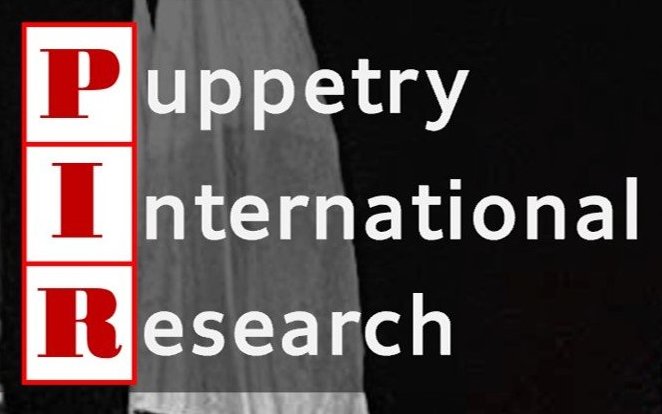BRAVE NEW SCHOLARSHIP
SPRING/SUMMER 2012 ISSUE NO. 31
Table of Contents • Editor's Note
We are fortunate to have Dassia Posner on board as our Guest Editor for this issue. You'll learn more about Dassia's background in her introduction to this issue, but regular readers of this magazine are already familiar with her work. In addition to writing articles and reviews for PI, Dassia (along with John Bell) has been helping to plan our issues for the past five or six years. The process is congenial and a little dreamlike, as the three of us gather around a dining room table over a cup of herb tea and ponder the many facets of our chosen theme, and how it should be covered and who should write what.
Dassia has moved to Chicago to join the Theater Faculty at Northwestern University, but we still meet, her face on a laptop now thanks to video-conferencing technology. What has impressed me about recent puppet scholarship, is that the new wave of MFAs and PhDs almost always began their careers as puppeteers. As you might suspect, the MFA's continue to create new work for the theatre, yet even some PhD's continue front their own puppet companies. Perhaps this is why the new puppet re- search has such energy to it—these researchers know their topic from the inside out. We hope you enjoy these articles. There are also reviews of some new books, and a look at the new documentary about Kevin Clash: Being Elmo.
-Andrew C. Periale
The New Vocabulary of the Puppet
My first foray into puppetry scholarship was a graduate paper on Julie Taymor's puppets and masks for Gozzi's King Stag, directed by Andrei Serban at the American Repertory Theatre (1984, remounted 2000). At the time, I was surprised by theatre critics' struggle to articulate the contribution of puppets and masks to the production. It was praised for its "Magic" and "Cross-Cultural Whimsy," and even for moving "Beyond Miss Piggy," but was not evaluated for its intercultural dialogue with Indonesian topeng and Japanese bunraku, nor for its playful use of estrangement in the form of light-blue-clad-and-hooded puppeteers who manipulated both the tale and its puppets.
With the increasingly visible presence of puppetry in U.S. and European theatre in productions like The Lion King, Avenue Q, and War Horse, theatre critics have now begun to express less surprise at, and more analysis of, the theatrical pro-liferation of puppets. The last few years have also seen a burgeoning of strong, international puppetry scholarship. The need remains for this body of scholarship to continue to grow as we seek meaningful ways to talk about puppetry, investigate the philosophical questions it raises, discover how the puppet functions dramaturgically on the stage, and trace the integral place of puppetry in world performance culture.
I was recently part of a committee that organized the first international scholarly puppetry conference in the United States. "Puppetry and Postdramatic Performance: An International Conference on Performing Objects in the 21st Century," was held April 1-3, 2011 at the University of Connecticut, Storrs. The conference brought together a hundred and fifty scholars and artists from fourteen countries across six continents to explore "new approaches to critical thinking and theorizing about puppetry and performing objects in order to enrich, expand, and enliven the field of discourse." It featured seventy-five academic papers, keynote addresses by Peter Schumann and Eileen Blumenthal, workshops and performances, a film series, tours, and a puppet cabaret. It was planned by John Bell, Janie Geiser, Nicole Hartigan, Claudia Orenstein, Bart P. Roccoberton, Jr., Susan Simpson, and myself, with generous logistical support by Mary Mell, Ted Yungclas, and many volunteers. We organized it in conjunction with the University of Connecticut, CalArts, and the UNIMA Research Commission, with support from the Jim Henson Foundation, the UConn School of Fine Arts, and the Bal- lard Institute and Museum of Puppetry.
This issue of Puppetry International is inspired by that conference. Several of the issue's articles, written by both established and emerging scholars, were first presented at the conference, while others are entirely new. These articles, while diverse in their geographical, temporal, and philosophical areas of inquiry, cumulatively investigate and celebrate puppetry's presence in the margins of theatrical culture. By this, I do not mean that puppetry is marginalized, but that its significance and appeal lie in its "betweenness," in its ability to be read simultaneously as human and object, as neither and both. As these seven authors observe, the puppet hovers tantalizingly between life and death, tradition and innovation, the serious and the satirical, the enthralling and the uncanny, ritual and theatre, and, as Chikamatsu Monzaemon famously stated, "between the real and the not real."
Puppetry scholars have recently been honing a vocabulary that articulates the uniquely rich, varied, sophisticated, and expressive language of puppet and object theatre. It is my hope that this issue of Puppetry International, the first to be entirely peer-reviewed, will help that vocabulary to grow.
-Dassia N. Posner




